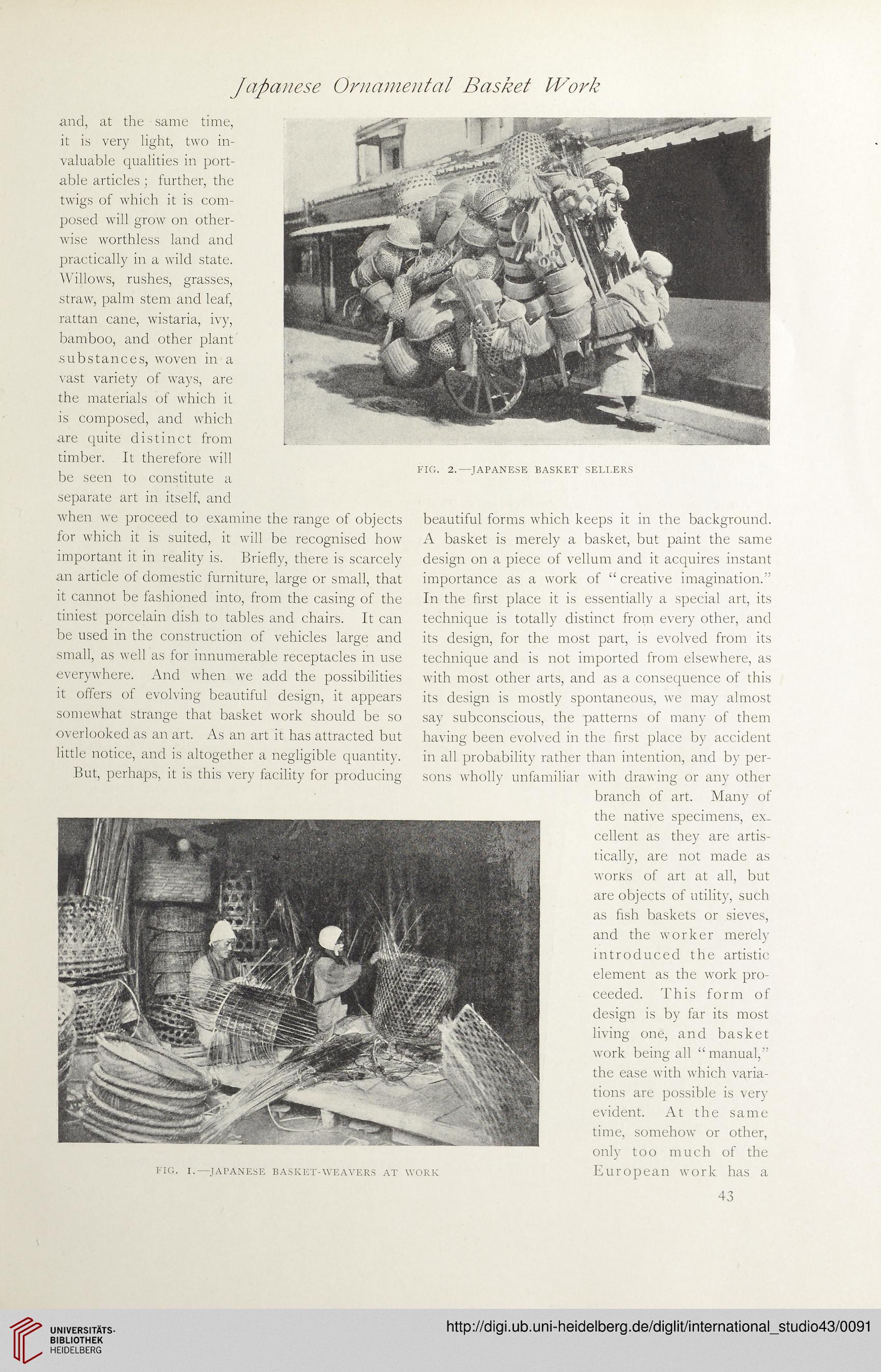Japanese Ornamental Basket Work
and, at the same time,
it is very light, two in-
valuable qualities in port-
able articles ; further, the
twigs of which it is com-
posed will grow on other-
wise worthless land and
practically in a wild state.
Willows, rushes, grasses,
straw, palm stem and leaf,
rattan cane, wistaria, ivy,
bamboo, and other plant
substances, woven in a
vast variety of ways, are
the materials of which it
is composed, and which
are quite distinct from
timber. It therefore will
be seen to constitute a
FIG. 2.—JAPANESE BASKET SELLERS
separate art in itself, and
when we proceed to examine the range of objects
for which it is suited, it will be recognised how
important it in reality is. Briefly, there is scarcely
an article of domestic furniture, large or small, that
it cannot be fashioned into, from the casing of the
tiniest porcelain dish to tables and chairs. It can
be used in the construction of vehicles large and
small, as well as for innumerable receptacles in use
everywhere. And when we add the possibilities
it offers of evolving beautiful design, it appears
somewhat strange that basket work should be so
overlooked as an art. As an art it has attracted but
little notice, and is altogether a negligible quantity.
But, perhaps, it is this very facility for producing
beautiful forms which keeps it in the background.
A basket is merely a basket, but paint the same
design on a piece of vellum and it acquires instant
importance as a work of “ creative imagination.”
In the first place it is essentially a special art, its
technique is totally distinct from every other, and
its design, for the most part, is evolved from its
technique and is not imported from elsewhere, as
with most other arts, and as a consequence of this
its design is mostly spontaneous, we may almost
say subconscious, the patterns of many of them
having been evolved in the first place by accident
in all probability rather than intention, and by per-
sons wholly unfamiliar with drawing or any other
branch of art. Many of
the native specimens, ex-
cellent as they are artis-
tically, are not made as
works of art at all, but
are objects of utility, such
as fish baskets or sieves,
and the worker merely
introduced the artistic
element as the work pro-
ceeded. This form of
design is by far its most
living one, and basket
work being all “ manual,”
the ease with which varia-
tions are possible is very
evident. At the same
time, somehow or other,
only too much of the
European work has a
1'IG. I.—JAPANESE BASKET-W'EAVERS AT WORK
43
and, at the same time,
it is very light, two in-
valuable qualities in port-
able articles ; further, the
twigs of which it is com-
posed will grow on other-
wise worthless land and
practically in a wild state.
Willows, rushes, grasses,
straw, palm stem and leaf,
rattan cane, wistaria, ivy,
bamboo, and other plant
substances, woven in a
vast variety of ways, are
the materials of which it
is composed, and which
are quite distinct from
timber. It therefore will
be seen to constitute a
FIG. 2.—JAPANESE BASKET SELLERS
separate art in itself, and
when we proceed to examine the range of objects
for which it is suited, it will be recognised how
important it in reality is. Briefly, there is scarcely
an article of domestic furniture, large or small, that
it cannot be fashioned into, from the casing of the
tiniest porcelain dish to tables and chairs. It can
be used in the construction of vehicles large and
small, as well as for innumerable receptacles in use
everywhere. And when we add the possibilities
it offers of evolving beautiful design, it appears
somewhat strange that basket work should be so
overlooked as an art. As an art it has attracted but
little notice, and is altogether a negligible quantity.
But, perhaps, it is this very facility for producing
beautiful forms which keeps it in the background.
A basket is merely a basket, but paint the same
design on a piece of vellum and it acquires instant
importance as a work of “ creative imagination.”
In the first place it is essentially a special art, its
technique is totally distinct from every other, and
its design, for the most part, is evolved from its
technique and is not imported from elsewhere, as
with most other arts, and as a consequence of this
its design is mostly spontaneous, we may almost
say subconscious, the patterns of many of them
having been evolved in the first place by accident
in all probability rather than intention, and by per-
sons wholly unfamiliar with drawing or any other
branch of art. Many of
the native specimens, ex-
cellent as they are artis-
tically, are not made as
works of art at all, but
are objects of utility, such
as fish baskets or sieves,
and the worker merely
introduced the artistic
element as the work pro-
ceeded. This form of
design is by far its most
living one, and basket
work being all “ manual,”
the ease with which varia-
tions are possible is very
evident. At the same
time, somehow or other,
only too much of the
European work has a
1'IG. I.—JAPANESE BASKET-W'EAVERS AT WORK
43




